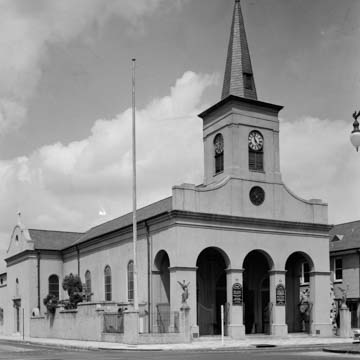Because it was believed that corpses laid out for burial were a source of contagion for yellow fever, the wardens of St. Louis Cathedral established a mortuary chapel outside the original city limits. Burial took place in St. Louis Cemetery No. 1 (OR32) behind the chapel. The triple-arched facade of this stuccoed brick building rises to a curved parapet and square belfry tower. Over time, the chapel assumed the duties of a parish church, celebrating Mass and offering baptisms, communions, and weddings. By 1873, the chapel served Italian immigrants settling in this area and was dedicated to St. Anthony of Padua. In 1903, the Dominicans took over the chapel and replaced the tower’s dome with a steeple and clock. Subsequently, the Oblates of Mary Immaculate, from San Antonio, Texas, took charge of the chapel in 1918. With the expectation of a large Mexican congregation (which never materialized), they renamed it Our Lady of Guadalupe in honor of Mexico’s patron saint. In the 1920s, architects Diboll and Owen refurbished the chapel, and the Emil Frei Art Glass Company of St. Louis created the stained glass windows. A replica of the grotto at Lourdes was added in 1924, and a shrine to St. Jude, the patron saint of hopeless causes, was installed in 1935. The chapel was enlarged and remodeled in 1952.
You are here
Our Lady of Guadalupe Chapel (Mortuary Chapel)
If SAH Archipedia has been useful to you, please consider supporting it.
SAH Archipedia tells the story of the United States through its buildings, landscapes, and cities. This freely available resource empowers the public with authoritative knowledge that deepens their understanding and appreciation of the built environment. But the Society of Architectural Historians, which created SAH Archipedia with University of Virginia Press, needs your support to maintain the high-caliber research, writing, photography, cartography, editing, design, and programming that make SAH Archipedia a trusted online resource available to all who value the history of place, heritage tourism, and learning.





















